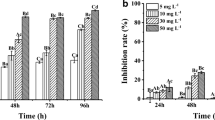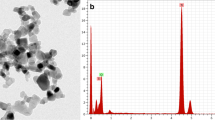Abstract
This constitutes the first study to report on the reduction in toxicity of the dinoflagellate algal toxin okadaic acid after novel pulsed light (PL) treatments where ecotoxicological assessment was performed using a miniaturised format of the conventional in vivo freshwater crustacean Daphnia sp. acute toxicity test. Bivalves accumulate this toxin, which can then enter the human food chain causing deleterious health effects such as diarrhetic shellfish poisoning. This miniaturised toxicological bioassay used substantially less sample volume and chemical reagents. Findings revealed a 24-h EC50 of 25.87 μg/L for PL-treated okadaic acid at a UV dose of 12.98 μJ/cm2 compared to a 24-h EC50 of 1.68 μg/L for the untreated okadaic acid control, suggesting a 15-fold reduction in toxicity to Daphnia pulex. The bioassay was validated in this study and correlated well with the “classic” ISO format (r = 0.98) using the traditional reference chemical potassium dichromate (K2Cr2O7). Reduction by up to 65% in PL-treated okadaic acid concentration was confirmed by LC-MS/MS analysis. Findings from this study have positive ecological, societal and enterprise implications, such as the development of PL technology for the prevention or reduce algal contamination of fisheries and aquaculture industries.





Similar content being viewed by others
References
Baumann J, Sakka Y, Bertrand C, Köser J, Filser J (2014) Adaptation of the Daphnia sp. acute toxicity test: miniaturization and prolongation for the testing of nanomaterials. Environ Sci Pollut Res Int 21(3):2201–2213. https://doi.org/10.1007/s11356-013-2094-y.
Ben-Gigirey B, Rodríguez-Velasco M, Villar-González A, Botana L (2007) Influence of the sample toxic profile on the suitability of a high performance liquid chromatography method for official paralytic shellfish toxins control. J Chromatogr A 1140(1–2):78–87
Bord Iascaigh Mhara, Irish Sea Fisheries Board, (2015). 2014 BIM annual aquaculture survey. [online] Available at: http://www.bim.ie/media/bim/content/publications/BIM%20Aquaculture%20Survey%202014.pdf [Accessed 25 Jun. 2015].
FAO, 2016. The state of word fisheries and aquaculture Rome, Italy
Farrell HP, Hayes J, Laffey JG, Rowan NJ (2011) Studies on the relationship between pulsed UV light and the simultaneous occurrence of molecular and cellular damage in clinically-relevant Candida albicans. J Microbiol Methods 84:317–326
FSAI.ie, (2015). Health standards | aquaculture | food legislation | legislation | The Food Safety Authority of Ireland. [online] Available at: https://www.fsai.ie/legislation/food_legislation/aquaculture/health_standards.html [Accessed 25 Jun. 2015]
Fux E, Bire R, Hess P (2009) Comparative accumulation and composition of lipophilic marine biotoxins in passive samplers and in mussels (M. edulis) on the West Coast of Ireland. Harmful Algae 8:523–537
Fux E, Smith JL, Tong M, Guzman L, Anderson DM (2011) Toxin profiles of five geographical isolates of Dinophysis spp. from North and South America. Toxicon 57:275–287
Garvey M, Farrell H, Cormican M, Rowan NJ (2010) Investigations of the relationship between use of in vitro cell culture-quantitative PCR and a mouse-based bioassay for evaluating critical factors affecting the disinfection performance of pulsed UV light for treating Cryptosporidium parvum oocyts in saline. J Microbiol Methods 80:267–273
Garvey M, Stocca A, Rowan NJ (2014) Development of a combined in vitro cell culture-quantitative PCR assay for evaluating the disinfection performance of pulsed light for treating the waterborne enteroparasite Giardia lamblia. Experimental parasitology 144(1):6–13
Garvey M, Hayes J, Clifford E, Rowan N (2015) Ecotoxicological assessment of pulsed ultraviolet light-treated water containing microbial species Cryptosporidium parvum using a microbiotest battery. Water and Environment Journal 29:27–35. https://doi.org/10.1111/wej.12073
Garvey M, Stocca A, Rowan N (2016) Use of a real-time PCR assay to assess the effect of pulsed light inactivation on bacterial cell membranes and associated cell viability. Water Environ Res 88(2):168–174
Gerssen A, Mulder PPJ, de Boer J (2011) Screening of lipophilic marine toxins in shellfish and algae: development of a library using liquid chromatography coupled to orbitrap mass spectrometry. Anal Chim Acta 685:176–185
Hayes J, Kirf D, Garvey M, Rowan N (2013) Disinfection and toxicological assessments of pulsed UV and pulsed-plasma gas-discharge treated-water containing the waterborne protozoan enteroparasite Cryptosporidium parvum. J Microbiol Methods 94(3):325–337. https://doi.org/10.1016/j.mimet.2013.07.012
International Organisation for Standardisation International Standard ISO 6341 (2012) Water quality—determination of the inhibition of the mobility of Daphnia magna Straus (Cladocera, Crustacea)—acute toxicity testn.d.
Kumagai M, Yanagai T, Murata M, Yasumoto T, Kat M, Lassus P, Rodriguez-Vazquez J (1986) Okadaic acid as the causative toxin of diarrhetic shellfish poisoning in Europe. Agric Biol Chem 50(11):2853–2857. https://doi.org/10.1080/00021369.1986.10867817
Lilius H, Hästbacka T, Isomaa B (2005) Short communication: a comparison of the toxicity of 30 reference chemicals to Daphnia magna and Daphnia pulex. Environ Toxicol Chem 14(2):2085–2088. https://doi.org/10.1002/etc.5620141211.
Luppis A, Katikou P, Georgantelis D, Badeka A, Kontominas M (2011) Effect of ozonation and γ-irradiation on post-harvest decontamination of mussels (Mytillus galloprovincialis) containing diarrhetic shellfish toxins. Food Additives & Contaminants: Part A 28(12):1735–1744
Naughton J, Tiedeken EJ, Stout J, Rowan NJ (2017) Pulsed light inactivation of the bumble bee trypanosome parasite Crithidia bombi. Journal of Apiculture Research 56(2):144–154
OECD (2004) Test No. 202: Daphnia sp. Acute Immobilisation Test, OECD Publishing, Paris. http://doi.org/10.1787/9789264069947-en
Prego-Faraldo MV, Valdiglesias V, Méndez J, Eirín-López JM (2013) Okadaic acid meet and greet: an insight into detection methods, response strategies and genotoxic effects in marine invertebrates. Marine Drugs 11(8):2829–2845. https://doi.org/10.3390/md11082829
Rowan NJ (2011) Defining Established and Emerging Microbial Risks in the Aquatic Environment: Current Knowledge, Implications, and Outlooks. Int J Microbiol 2011:15. https://doi.org/10.1155/2011/462832
Rowan N, Valdramidis VP, Gomez-Lopez VM (2016) A review of quantitative methods to describe efficacy of pulsed light inactivation data that embraces the occurrence of viable non culturable microorganisms. Trends Food Sci Technol 44(1):79–92
Twiner MJ, Rehmann N, Hess P, Doucette GJ (2008) Azaspiracid shellfish poisoning: a review on the chemistry, ecology, and toxicology with an emphasis on human health impacts. Mar. Drugs 6(2):39–72
Vernoux JP, Le Baut C, Masselin O, Marais C, Baron B, Choumiloff R, Pronieewski F, Nizard G, Bohec M (1993) The use of Daphnia magna for detection of okadaic acid in mussel extracts. Food Addit Contam 10(5):603–608. https://doi.org/10.1080/02652039309374184
Yasumoto T, Oshima Y, Yamaguchi M (1978) Occurrence of a new type of shellfish poisoning in Tohoku District. Bull Jpn Soc Sci Fish 44(11):1249–1255
Acknowledgements
The component of research conducted at Queen’s University was funded by the Advanced ASSET project, partly funded through InvestNI and from the European Sustainable Programme 2007–2013 under the European Regional Development Fund (‘ERDF’).
The component carried out in Athlone Institute of Technology was funded by the Institute’s Department of Life and Physical Sciences with thanks to Head of Department Dr. Carol O’ Donnell and Dean of Faculty of Science Dr. Don Faller.
Author information
Authors and Affiliations
Corresponding author
Additional information
Responsible editor: Vitor Manuel Oliveira Vasconcelos
Electronic supplementary material
ESM 1
(DOCX 601 kb)
Rights and permissions
About this article
Cite this article
Murray, I.M.T., Rowan, N.J., McNamee, S. et al. Pulsed light reduces the toxicity of the algal toxin okadaic acid to freshwater crustacean Daphnia pulex . Environ Sci Pollut Res 25, 607–614 (2018). https://doi.org/10.1007/s11356-017-0472-6
Received:
Accepted:
Published:
Issue Date:
DOI: https://doi.org/10.1007/s11356-017-0472-6




